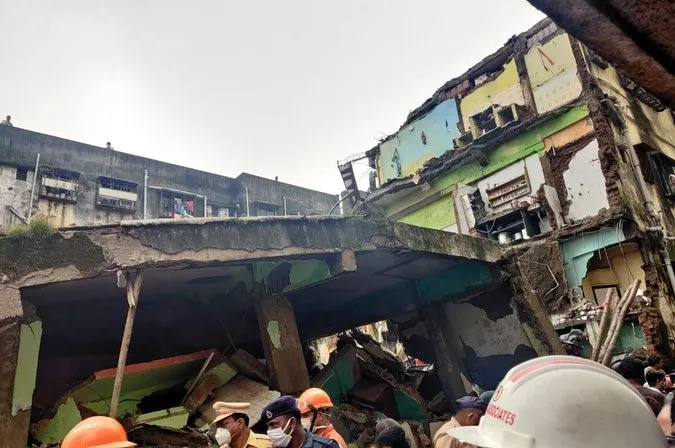-
CENTRES
Progammes & Centres
Location
Solutions to the problem are pretty obvious. The first step is to set the policy right. Governments have to begin by scrapping the rent laws as they stand.

Bhiwandi, a city 15 km from Thane and part of the Mumbai Metropolitan Region (MMR), is home to the largest number of textile power looms in the country. In 1976, its population was less than 100,000. However, in the 1980s and 90s, the town grew rapidly and is now close to becoming a metropolitan city (one million population). Its industries and their need for labour have drawn people in large numbers, resulting in a huge amount of housing and other construction. Unfortunately, part of such construction and the city’s expansion have paid little attention to building norms and principles of healthy town planning. Such cavalier urbanisation was bound to have its downside.
On the morning of 21 September 2020, a three-storey building in Bhiwandi came crashing down killing more than three dozen people in their sleep and injuring another two dozen. It was not a very old building. It had been erected three and a half decades ago. Evidently, building regulations had been compromised. The Bhiwandi-Nizampur Municipal Corporation, the urban local body (ULB) in charge of the city’s governance was aware of this structure’s problems and had served repeated notices to the owner. These went unheeded and the authorities showed no inclination to move beyond written warnings. As usual, enquires have been ordered and two civic officials have been suspended while the National Disaster Response Force (NDRF) assisted the ULB and its fire services to deal with the disaster.
"It was not a very old building. It had been erected three and a half decades ago. Evidently, building regulations had been compromised."
A further encouraging development is that the Bombay High Court has taken suo motu cognisance of the matter. In the process of hearing a case of construction in Kalyan-Dombivali, the Chief Justice remarked, “A building has collapsed in Bhiwandi, several lives have been lost. We are told the situation is quite serious in Mumbai too.” He further added, “We are making the state and all municipal corporations parties and issuing notices.” Hopefully, the final directives of the high court would lead to a more pro-active attempt by the urban local bodies to tackle the growing menace of unauthorised constructions.
While this building was a case of substandard structure, illegal construction and building activity in violation of development control regulations appears to be a flourishing practice in large parts of MMR. An activist alleges that in the last five years five hundred illegal buildings, erected with inferior material, and more than what could be permitted under rules, have mushroomed in Bhiwandi. Access paths for fire brigade and mandatory open marginal spaces are rampantly ignored. As a result, in the event of a disaster, approaching the building through narrow lanes and carrying out proper evacuation is hugely difficult. Bhiwandi alone, however, is not guilty of such violations. Ulhasnagar and Mumbra are equally non-compliant. In fact, the 2013 collapse of an illegal building in Mumbra was one of the worst tragedies of this kind in which 74 lives were lost.
"Access paths for fire brigade and mandatory open marginal spaces are rampantly ignored."
Along with illegal and poor construction, MMR is also home to many old and dilapidated buildings that are dangerous, meaning thereby that they are precariously standing and are in need of major repairs. There were 4,500 of them in Thane that civic authorities counted some time back. Of these, 79 were extremely dangerous, meaning that they could fall any moment and needed to be pulled down. In Mumbai itself, more than 14,000 buildings are over the age of 50 years. On account of lack of maintenance, they are endangered. Thus, we have a situation where the MMR is replete with constructions that have overstepped beyond the rule book, others that are completely illegal as well as dilapidated structures that could fall anytime during the next few years.
The worrying part is that in the past decades not much has been done about them. In the case of old dilapidated structures, the biggest culprit is the alacrity of cities and government to allow the growth of economic activity in the region, but not to back the economy with adequate numbers of affordable housing. Surely, the worker cannot participate in the economy without a roof over his head. Private production of affordable housing was never of much interest to the market; but it was further heavily impeded by Maharashtra’s rental legislation that loaded laws in favour of tenants in complete disregard of the landlords. Rents got pegged at low levels with abysmally small rise and tenants could not be evicted. It was logical, therefore, for landlords to neglect maintenance of the structures they owned and leave the tenants to their fate.
"In the case of old dilapidated structures, the biggest culprit is the alacrity of cities and government to allow the growth of economic activity in the region, but not to back the economy with adequate numbers of affordable housing."
In its search for a solution to deteriorating structures, government came up with the Repairs and Reconstruction Board. It recovered a cess from tenants for repairs and attempted to provide the tenants with safer housing. Unfortunately, neither was the money sufficient nor the government efficient in spending that money. The performance of the Board, therefore, has been mired in controversies and all-round dissatisfaction. The consequence has been tragic. Municipal authorities serve notice on the owners and tenants of dilapidated structures. However, they cannot do much else, as the landlord earns very little from the building to invest in repairs. On the other hand, tenants cannot move out as they would be priced out of any housing in a hugely costly market and would be left without a roof over their head. We, therefore, have the heart-rending annual routine of some buildings falling and killing some of their residents.
The good part about the other kind — the illegal structures — is that they provide some kind of housing. The bad part is that they are not soundly built and some of them put people’s lives at risk. The municipal authorities are partly to blame for not using their powers to stop and demolish such constructions. But this is easier said than done. Officers in the past who have dared to implement the rule book have faced threats and murderous attacks on their lives. For instance, in Ulhasnagar, in November 2018, residents complained about the construction of illegal shops and nuisance emanating out of the shops. When the Joint Commissioner of the Ulhasnagar Municipal Corporation took cognizance of the complaint and reached the site to demolish the illegal shops, he was beaten up by a group of fifteen locals. Such incidents have not been isolated. Clearly, in parts of the MMR, unauthorised construction is supported by political parties and backed by muscle power. In all fairness, however, it must also be added that illegal construction is now more or less a national urban phenomenon and plenty of examples could be found in almost all large cities of the country.
"The municipal authorities are partly to blame for not using their powers to stop and demolish such constructions. But this is easier said than done."
Solutions to the problem are pretty obvious. The first step is to set the policy right. Governments have to begin by scrapping the rent laws as they stand. States need to bring in legislation that balances the interests of the landlord with the tenant. In 2015, the Ministry of Urban Development, Government of India, came up with a draft of the National Urban Rental Housing Policy (NURHP) and followed it up with a Model Tenancy Act draft in 2019. Both recommend a legal framework that seeks to balance the interests of the landlord and the tenant.
The proposed model law can be adopted by the states. Additionally, governments have to play a central role in the provision of affordable housing. This needs to cover housing both for ownership and for rent. It must invest, encourage and promote the construction of good, affordable housing. This will marginalise rather than centralise illegal constructions which it can then prevent through proper policing. Given the scale of the problem, any policing effort without policy reform will stand defeated.
The views expressed above belong to the author(s). ORF research and analyses now available on Telegram! Click here to access our curated content — blogs, longforms and interviews.

Dr. Ramanath Jha is Distinguished Fellow at Observer Research Foundation, Mumbai. He works on urbanisation — urban sustainability, urban governance and urban planning. Dr. Jha belongs ...
Read More +